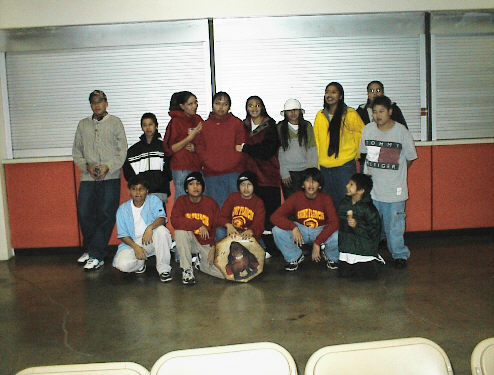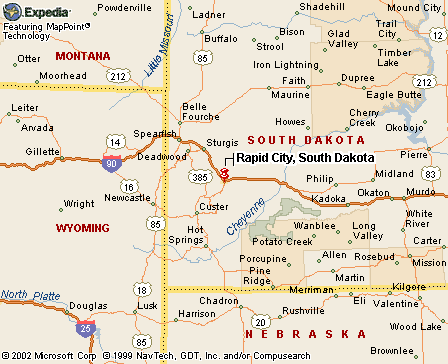|
|
Canku Ota |
|
|
(Many Paths) |
||
|
An Online Newsletter Celebrating Native America |
||
|
December 28, 2002 - Issue 77 |
||
|
|
||
|
Hand Game a Hit at Lakota Nation Invitational |
||
|
by Heidi Bell Glease
Rapid City Journal
|
||
|
credits: Photo 1:Crow Hand Game Pieces courtesy Plenty Coups College; Photo 2: The St. Francis Indian School Lakota Hand Game Team also participated in the hand game tournament at the 23rd Annual Lakota Nation Invitational courtesy St. Francis Indian School |
 RAPID
CITY, SD -- On the basketball court at the Lakota Nation Invitational
tournament, the game is a physical blend of shooting, defensive hustle
and ball-handling, set to the sound of cheering fans and clock buzzers. RAPID
CITY, SD -- On the basketball court at the Lakota Nation Invitational
tournament, the game is a physical blend of shooting, defensive hustle
and ball-handling, set to the sound of cheering fans and clock buzzers.
But behind the bleachers, there's another contest under way, and it's all about concentration, distraction and sleight of hand. This is the fifth annual LNI hand-game tournament, where teams compete for trophies and jackets in what essentially is a guessing game accompanied by singing and drumming. "It's like a mental game," said Ohitika Tasso, a senior at Pine Ridge High School who has been playing hand games all his life. "You do a lot with your mind." Hand games, also called stick games or moccasin games, have been played by various American Indian tribes for hundreds of years. There are as many versions as there are tribes. It originally was a betting game, with players wagering hides or horses or weaponry on their skills. "No one knows how old it is," Wilmer Mesteth of Pine Ridge, who was judging Friday's matches, said.
Here's how it works: Two teams of five to 10 players sit facing each other. Each team starts the game with five beaded sticks, usually displayed in an antler stand in front of them. One team's captain chooses two people to hide the "dice," which are pieces of bone or antler about 2 inches long. In the Flathead version of the game being played at LNI, two of the four bones are plain and two are marked with a line. "In this game you're looking for the one that doesn't have a mark," Tasso said. The other team's captain chooses a player to be the guesser. The hider conceals the bones in his or her hands, maybe mixing them up inside a sweatshirt pocket or under a jacket. Then the guesser tries to figure out which hand contains the unmarked bone. If he guesses correctly, the dice are handed over to the other team. If she guesses wrong, her team must give up a stick to the opponents, and the opponent hides the dice again. After the guesser has won back both sets of dice, that team hides, and the other team guesses. When one team has won all the sticks - including an 11th "kick stick," an advantage the teams compete for at the beginning - the game is over. It's not as simple as it might sound. Trickery is a key strategy, particularly distracting the guesser. Both teams have a person singing and playing a hand drum while his team is hiding the dice. Meanwhile, other team members make hand motions or clap, trying to divert the guesser's attention. But the guessing side has tricks, too. One is to have a team member who is not the official guesser guess where the dice are. "If you open up your hand for the wrong guesser, you lose the dice," Roger White Eyes, a Lakota studies instructor at Red Cloud Indian School who is running the hand-game tournament, said. "A lot of the newer teams that have less experience, they'll always fall for that." That's why, for youth tournaments such as this one, someone such as Mesteth judges the games. He keeps things fair and makes sure no one cheats. If the game goes on too long, he pulls a stick from each side to speed things up. Otherwise, hand games can last for hours, White Eyes said. "It's just exciting because the sticks can go all the way over to one side and then come back." This is the first year that St. Francis Sicangu Lakota sophomore Rosie Leader Charge, junior Raina Two Lance and senior Marless Crow Eagle have played hand games, but they learned quickly from teammates such as Elida Bad Hand, a sophomore who played last year. Crow Eagle found communication is a crucial part of the game. Two Lance learned to read body language. "And you've got to pay attention," Leader Charge said. "If you look them straight in the eye, they'll usually give up what hand it's in." Most students enjoy both guessing and hiding. "I like the tricking part, making them nervous," Leader Charge said. "I like the winning part," Two Lance put in. White Eyes knows that some players, like poker players, try to "read" how others will play. But when asked what makes a good player, he smiled. "I guess you have to be a pretty lucky guesser." Maybe there's more to it, though. "There's also mythological beliefs related to this," Mesteth said. Legend is that spirits taught the people hand games and that spiritual forces watch the games. Good spirits keep players honest, but evil ones cause them to cheat. "I encourage these kids to learn these (hand-game) songs. Some songs have power," Mesteth said. "If they sing them right, they have luck on their side." White Eyes and Bob Braveheart are putting together an instructional DVD on hand games, including rules and hand-game songs, to be released next year.
|
|
|
||
|
|
||
| Canku Ota is a free Newsletter celebrating Native America, its traditions and accomplishments . We do not provide subscriber or visitor names to anyone. Some articles presented in Canku Ota may contain copyright material. We have received appropriate permissions for republishing any articles. Material appearing here is distributed without profit or monetary gain to those who have expressed an interest. This is in accordance with Title 17 U.S.C. section 107. | ||
|
Canku Ota is a copyright © 2000, 2001, 2002 of Vicki Lockard and Paul Barry. |
||
 |
 |
|
|
The "Canku Ota - A Newsletter Celebrating Native America" web site and its design is the |
||
|
Copyright © 1999, 2000, 2001, 2002 of Paul C. Barry. |
||
|
All Rights Reserved. |
||
 What
is known is that sometime during the past hundred years, hand games
died out in many tribes. Mesteth has spent 20 years trying to revive
the games among area tribes, and his efforts are paying off: There are
15 high school teams at this year's tournament, and hand games have
become popular across the state. "We're really proud of that, bringing
this game back," Mesteth said.
What
is known is that sometime during the past hundred years, hand games
died out in many tribes. Mesteth has spent 20 years trying to revive
the games among area tribes, and his efforts are paying off: There are
15 high school teams at this year's tournament, and hand games have
become popular across the state. "We're really proud of that, bringing
this game back," Mesteth said.